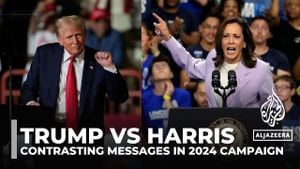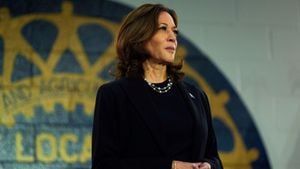With the 2024 U.S. presidential election drawing near, Pennsylvania has emerged as the battleground state, becoming the focal point for both Vice President Kamala Harris and former President Donald Trump. On the eve of election day, both candidates are executing last-minute strategies to sway voters, knowing full well the significance of this key state.
Harris has planned multiple events across Pennsylvania, capping off her campaign with star-studded rallies featuring celebrities like Oprah Winfrey. This approach highlights the Democrats' strategy of engaging younger and more diverse voters who may be influenced by popular figures. Notably, Harris begins her election eve tour with events in Scranton, Allentown, Reading, and finishes with massive rallies planned for Pittsburgh and Philadelphia.
Meanwhile, Trump is hitting the campaign trail hard, holding two rallies, including one at the Santander Arena in Reading, emphasizing the need to energize his base. He recognizes how pivotal Pennsylvania's 19 electoral votes are, and his team is counting on solid turnout from the state's conservative regions to seal victory.
Political analyst Nate Silver highlighted the stakes of this election, noting the candidate who secures Pennsylvania is more than likely to win the presidency. The historical significance of Pennsylvania cannot be understated; it has been called the "granddaddy of swing states" and is often seen as reflective of the entire U.S. demographically and politically.
Demographically, Pennsylvania's population is predominantly white but includes growing Hispanic and immigrant communities. The state’s political identity is complicated, with urban centers like Philadelphia and Pittsburgh leaning Democratic, contrasting sharply with rural areas where Republican support is strong. This unique mix makes Pennsylvania’s election results particularly challenging to predict.
Statistics show how close things have been: President Biden won by about 80,000 votes in 2020, following Trump's narrow victory of 40,000 over Hillary Clinton back in 2016. Polls leading up to the election indicate both candidates are nearly neck-and-neck, with the final New York Times/Siena College poll showing them tied at 48% among likely voters.
Both campaigns are pouring resources and time—particularly on television ads—into Pennsylvania. Harris introduced her running mate, Tim Walz, at events aimed at rallying more progressive voters, and Trump has been strategizing to capitalize on the goodwill from his past presidency to resonate with constituents.
Critics have pointed out the challenges each candidate faces, particularly with voter engagement. For Harris, the goal is to capture significant margins within urban areas and suburbs to offset Trump’s strength across other demographics. It's also key to win over moderate voters, especially from the Republican side, as they are seen as potentially swaying the election's outcome.
Trump's team, on the other hand, is focusing on mobilizing traditionally less engaged conservative voters, hoping to offset the slight edge Democrats hold among registered voters. According to Republican strategist Farah Jimenez, the campaign aims to connect with blue-collar union members and young black men—groups where Trump has shown recent progress. "If you can just convince them he speaks more to their concerns, you've laid the groundwork for GOP success here," she argues.
Polling indicates both campaigns are anticipating high mail-in ballot counts, especially since the pandemic shifted voting trends. Although mail-in voting is predicted to drop from last year's turnout, the early figures suggest there have been over 217,000 completed ballots already accounted for—ballots which won’t be opened until election night.
Compounding the situation is the expectation of close results similar to 2020, which led to delays and legal disputes over vote counting. Election officials are wary of potential disputes should the vote margin be narrow, as demonstrated four years ago when major media outlets didn’t project Biden as the winner until days later.
Trump's rhetoric at the final rallies has darkened, as he has openly expressed regret over leaving the White House. He mentioned, “I shouldn’t have left, I mean, honestly,” which has sparked concerns about the tone of his campaign as he doubles down on claims of widespread voter fraud—claims he has referenced repeatedly.
Both candidates have cultivated their unique approaches to wooing voters, but the outcome largely hinges on Pennsylvania's diverse electorate. The stakes couldn't be higher as each camp puts its best foot forward, appealing to every voter and every demographic. This element of uncertainty and the dynamics of voter preferences set the stage for what many predict will be one of the most closely watched elections yet.
No matter the outcome, Pennsylvania’s role as the keystone to either Harris or Trump's presidency cannot be understated, establishing itself yet again as the deciding factor for the nation.
Election day is fast approaching, and as the last-minute rallies fade, the attention will shift to the voters making their choices across the state and, inevitably, the nation.



